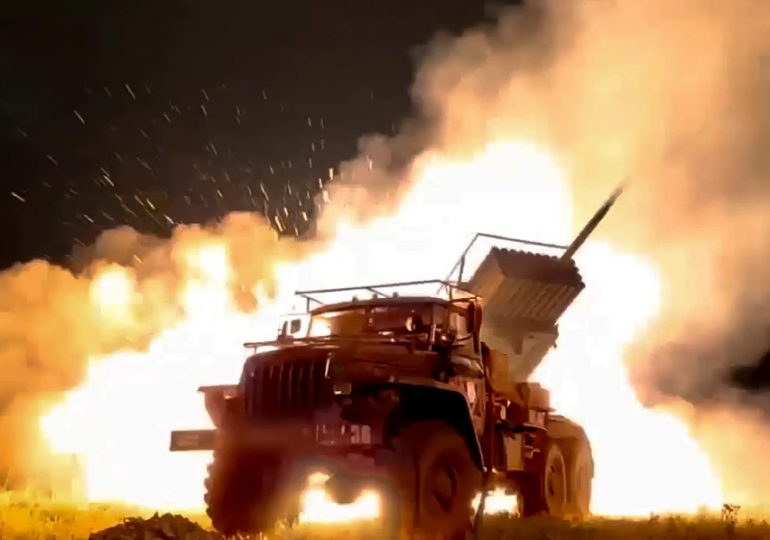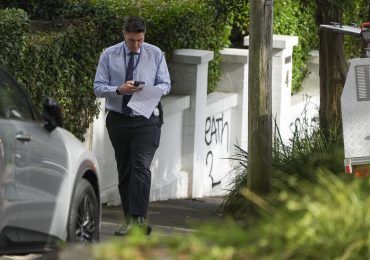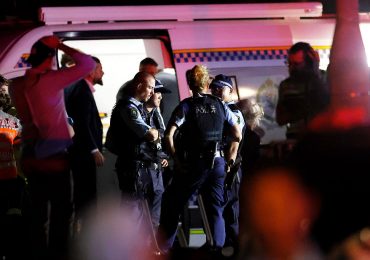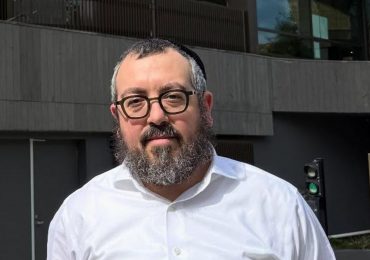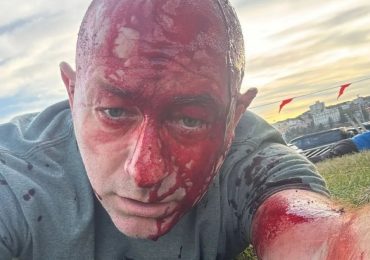VLADIMIR Putin will hurl troops into his “meatgrinder” war in 2025 at such a rate that he won’t be able to arm them all, experts have said.
Putin will continue luring soldiers to the frontline with propaganda and promises of cash in order to pry more land off Ukraine this year.
A Russian rocket launcher fires toward Ukrainian positionAP
GettyWorkers replace broken windows after a Russian rocket attack in Pokrovsk, Ukraine[/caption]
APDebris strewn across a street just metres from Ukraine’s Presidential Office following a drone strike on New Year’s Day[/caption]
ReutersVladimir Putin pictured during his New Year televised address to the nation[/caption]
But the tyrant may pay for his arrogance – with experts predicting Russia will fall short “at some point in 2025” of enough military equipment to to supply its forces.
Some 3,500 Russian tanks and 7,500 armoured vehicles have already been taken out of action.
Russian soldiers were slaughtered at an ever-growing rate in 2024, with each of the last five months breaking the record for the highest losses yet.
On November 4, Russia lost 2,030 men – the first time during the war that figure exceeded 2,000 for a single day.
Luke Pollard, the UK’s under-secretary for defence, predicted Russian losses – soldiers killed, wounded or captured – would reach one million within six months.
And Nick Reynolds, a land warfare expert at RUSI, warned that Putin Putin’s conscience is untouched by the mass death.
Mr Reynolds told The Sun: “Putin is notorious, historically, for being not particularly moved by human suffering.”
The dictator is had plenty of what British Defence Intelligence calls “tolerance for casualties”.
Despite the valiant efforts of Ukrainian soldiers, and a surprise invasion of Russia’s Kursk region in 2024, the communist power has been making record advances in recent months.
Whilst the military losses are still returning land gains for Putin, he is likely to press on, Mr Reynolds said.
Is Russia’s strategy working?
The Russian strategy in 2024 has been to stretch the frontline across a very large distance, which plays to their advantage as the larger army.
However, there has also been a recent step-up in offensive pressure.
Mr Reynolds said that the Russians are “no longer just holding the line, but trying to increase pressure” and, although the gains have been incremental, this strategy is working.
In November last year, Ukraine lost more land than any month since September 2022 – with an area almost the size of Greater London falling into Russian hands.
And data released by the Institute for the Study of War shows that Russia gained almost six times as much territory in 2024 as in 2023.
Russia’s latest focus has been Pokrovsk in Ukraine’s southern Donetsk region, where forces have pushed hard for months to claim the city, which had a pre-war population of 60,000.
Over the past few days, Russia has declared victories in villages around 10 miles from the main city, which suggests they are closing in.
Putin is notorious, historically, for being not particularly moved by human suffering
Nick Reynolds
Mr Reynolds believes it is only a matter of time until the city is taken – despite Vlad facing “heavy losses”.
He said: “I don’t see anything that can really change at this stage.
“Russia has forward momentum on the battlefield, though it is slow going.
“They are taking heavy losses and they lack the capability to really break the Ukrainian lines, so it is incremental, but it is working.”
Pokrovsk, though nearly destroyed, is a key logistics hub for Ukraine and would represent a significant victory for Russia.
APA Russian tank fires towards Ukrainian positions[/caption]
AFPUkrainian members of the 45th Artillery Brigade fire towards Russian positions in the Donetsk region[/caption]
ReutersFirefighters work at a site of a building damaged during a Russian drone strike on New Year’s Day in Kyiv[/caption]
APVladimir Putin is set to throw more troops into the Ukraine war ‘meatgrinder’, experts warn[/caption]
If they capture Pokrovsk, Putin’s forces could push on to the industrial city of Kramatorsk – which produces equipment for the Ukrainian military.
This gradual, grinding advance is Putin’s blood-soaked prize for sacrificing troops in such numbers.
He will see no reason to relent in 2025 whilst he is still making ground – and will continue sending troops to their deaths, Mr Reynolds said.
Ukraine did make a strategically significant advance into Russian territory in 2024 when they captured the Kursk region – and experts predict this will be an important bargaining chip – but the momentum lies squarely with Russia.
Matthew Savill, the director of military sciences at RUSI, told The Times: “In the past month the rate of Russian progress has accelerated. The Ukrainians are exhausted.
“They can’t pull units off the line, they are physically tired and mentally fatigued. There is no respite.”
Savill added: “Putin is willing to take gambles – he is on a winning streak and he is building up his pot.
“Why would he cash his chips now?”
Putin’s Ukraine war ‘meatgrinder’
The essence of Putin’s strategy is to flood the front line with enough troops to overwhelm the Ukrainians over time, in a war of attrition.
Expert estimates suggest there are around 200,000 Russian troops in Ukrainian territory at any one time.
For this brute force approach to work, Putin must continually replace the hundreds of thousands of soldiers he is losing.
And Russia wants to avoid a repeat of the deeply unpopular “partial mobilisation” announced in September 2022, which forced 300,000 military reservists and men with battle experience to fight.
Instead, it will continue brainwashing Russians with propaganda and luring them to the front line with financial incentives.
Mr Reynolds said: “Unfortunately, Russian propaganda domestically has been very effective, and there still seems to be a lot of support for the Putin administration.
“A large part of the domestic population, the electorate, has been convinced that overall Putin’s goals should be Russia’s goals.”
Part of this propaganda means “very tightly” controlling information, so Russians don’t understand the extent of the misery being inflicted upon them.
And when there has been any hint of “overt dissent” from civilians, the authorities have been “very successful at suppressing it”.
APRussian troops operating at an undisclosed location during the Ukraine war[/caption]
ReutersMembers of the artillery unit of the special rifle battalion of Zaporizhzhia region police fire towards Russian troops in a frontline[/caption]
GettyEmergency workers search for survivors after a missile strike in Kryvyi Rih, Ukraine[/caption]
EPAThe aftermath of an airstrike in Kharkiv, northeastern Ukraine[/caption]
Who is joining up?
So far, Putin has been very successful at replenishing his ranks.
“It looks like Russian recruitment of volunteers, of contract soldiers, is doing remarkably well,” Mr Reynolds said.
The tyrant has achieved this by targeting Russians who have no other options.
“It’s mostly people from east of the Urals and from rural areas being recruited – those from the poorest demographics,” Mr Reynolds added.
“There aren’t very many opportunities, so the financial incentives are attractive.
“For a lot of Russian men, life is not particularly good, so they try to better themselves economically.
“There’s a kind of poverty trap that a lot of Russian men may be trying to escape from.
“The unifying factor there is people from rural areas that are cut off from the metropolitan centre.”
A significant number of criminals were released from prison in order to fight in the war and continue to form a large portion of the Russian army.
There have been unsettling reports of these convicts returning to their home towns after being discharged and wreaking violence against civilians.
Russia has also assimilated North Koreans into its army.
There were reports in October that Kim Jong Un had shipped 12,000 North Korean troops over to Russia to fight for Putin.
AFPA Ukrainian resident weeps after her neighbours’ house was destroyed in a drone strike in Kharkiv[/caption]
APUkrainian firefighters put out a fire following a missile attack in Dnipropetrovsk region, Ukraine[/caption]
ReutersPeople take shelter at a metro station during Russia’s attack in Kyiv on Christmas Day[/caption]
Evidence began emerging in December that, after a training period, North Koreans had begun actively fighting on the front line – but they have suffered major losses.
Ukrainian president Zelensky said 3,000 North Korean soldiers – a quarter of the total force – had been killed or wounded within two weeks of joining the battlefield.
They are unfamiliar with weaponised drones, which have been picking them off in huge numbers according to footage released by the Ukrainian army.
They also don’t speak Russian, leading to at least one embarrassing friendly fire incident where Korean troops accidentally killed eight of Putin’s soldiers.
Although the 12,000 North Korean troops are being depleted quickly, they represent a significant foreign addition to Russia’s forces, and it is believed that Kim is lining up more reinforcements.
Could anything hold back the Russians?
The major challenge for Russia, Mr Reynolds said, is the supply of military equipment.
“Russia is outproducing Ukraine in terms of military weapons, but a lot of that is based on refurbishment of ground combat vehicles and artillery systems, for example,” he said.
“When they run out of systems to refurbish, which will happen in 2025 at some point, then they will start running into difficulties.
“They do have some capacity to manufacture some new systems, but they’re quite slow at it and we anticipate it will not be in high enough numbers to fulfil their needs.
“It’s not the only Russian pinch point, but it is the most significant one.”
The Russian economy is also in a precarious condition, which could fuel discontent, Mr Reynolds added.
Russian spending on defence has been extremely high, which has kept the economy afloat, but the “problems of doing that are starting to bite”.
He said: “We’ve already had very high inflation for the past year in Russia.
“Whilst there is still food on the shelves, it’s unaffordable for a lot of ordinary people, so there’s a growing dissatisfaction there.
“So far, it’s been capped and kept under control, but worsening economic conditions could change that.”
Twenty five years of Putin
By James Halpin
Putin has been ruling with an iron fist ever since he became president on New Year’s Eve 1999.
The swaggering KGB thug – then 47, now 72 – took over from the weak and booze-soaked Boris Yeltsin.
Despite originally trying to build bridges with the West, he proceeded to put Russia into a screeching reverse gear.
Over the next quarter of a century he veered the world back into a mire of distrust and put it on the brink of war – drawing the Iron Curtain closed once again just like the darkest days of the Cold War.
He has survived a coup attempt and wide-scale protests, mercilessly killed his enemies, invaded his neighbours and launched the biggest war in Europe since WW2.
But it is believed that despite his iron grip – Putin’s empire is still built on foundations of sand and could slip through his fingers.
Vlad’s great paranoia at the foundation of much of what he does is his deepseated fear of being deposed, dragged through the streets and killed – much like defeated Libyan dictator Gaddafi.
It’s a fear that will have been reignited after he was forced to offer shelter to dictator Assad – who was driven out of Syria in a lightning revolution.
On announcing he was stepping down, Putin’s predecessor Yeltsin slurred: “I am leaving. I have done all I could.”
Yeltsin told Putin to “take care” of Russia.
In response, Putin addressed Russia for the first time vowing to keep the country’s freedoms.
He said: “The freedom of speech, the freedom of conscience, the freedom of the media and property rights, these fundamental principles of a civilized society will be protected by the state.”
But Putin has systematically crushed the Russian people’s liberties as he has sought to keep himself in power.
Putin pictured in his first speech as President of Russia on NYE 1999
EPAPutin driving with his ally Kim Jong-Un[/caption]
Leave a comment
